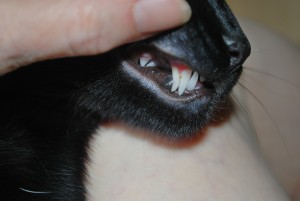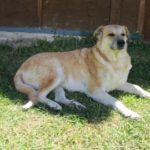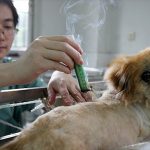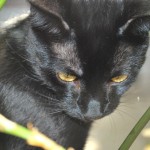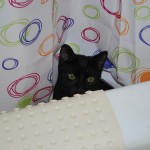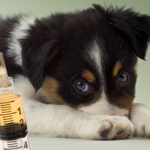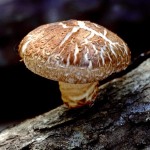Homeopathy Fixes My Cat’s Teeth
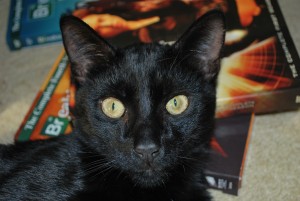
Or, how I used homeopathy to help correct an unusual dental problem.
I now have a new addition to my feline pride…
Meet Snaggle Tooth!
He came into my life on June 13th, which just happened to be a Friday (Friday the 13th!).
It was a rainy night, and a full moon hid behind the rain clouds. I was in the kitchen and heard a commotion outside my window. I looked out and saw a car stop in front of my building, the passenger door opened, and a black cat was tossed out on the sidewalk.
Poor thing!
The cat was hysterical. He was crying and wailing at the top of his lungs, pacing back and forth in front of the entrance, and probably wondering “Where the hell am I?”
I ran downstairs and picked up the cat. He was friendly, affectionate, and not one bit afraid of me. Purring a mile a minute, I gave him a good look-over. Clean ears, bright eyes, no fleas. I estimated his age to be about one-year old (and he’s sexually mature with all his naughty bits intact). He wouldn’t let me open his mouth, so I only saw a glimpse of his teeth. But the teeth I did see looked healthy and white. I named him Snaggle Tooth (read on and you’ll see why).
I took him upstairs and fed him (raw meaty bones, of course) and he inhaled the whole plate…
And, then I noticed something.
Next to the dish I saw two discarded baby teeth. I’m thinking, Whoa, wait a minute. This is a one-year old cat. He’s nearly twice the size of my adult five-year old male Burmese. A one-year old cat shouldn’t still have baby teeth!
Let’s pause for a second to talk about baby teeth in cats…
Kittens are born toothless. But, within the first two to three weeks the deciduous (“babyâ€) teeth erupt. All of the deciduous teeth should be present by 6 to 7 weeks of age. An 8-week-old kitten will have 26 teeth. These teeth are needle-like, fragile, and nearly translucent. At around 3 months of age, the baby teeth will fall out as the permanent teeth erupt and push the baby teeth out. And, if you take a close look at a discarded baby tooth you’ll notice that it appears hollow. All of the adult teeth should be present by 6 to 7 months of age. A normal adult cat will have 30 teeth.
Now, back to my story.
I put Snaggle on my knee and took a good look at his teeth… Oh, boy, did I have a shock. He had what is called retained deciduous teeth. It meant he had both adult and baby teeth (competing for the same space).
The cat had two sets of canines on the right. And, on the left, he had two sets of P2 106 pre-molar teeth. But, that wasn’t the strangest part. On both the upper sides of the mouth he had a thick flap of extraneous gum tissue hanging down. It hung so low that it covered the lower gum line. And, dangling on the bottom of these flaps was a row of 15 to 18 teeny-tiny square-shaped baby teeth (I wish I had taken a photograph of it).
I’ve never seen square-shape teeth on a cat!
I’m sitting there totally confused. I’m trying to imagine what kind of procedure, surgery, whatever, could correct something as crazy as this.
The only procedure I could do is homeopathy. So, I put my thinking-cap on and found several remedies for “difficult teething, delayed teething, painful teething…” I gave the cat a dose or two, and waited.
The next day I checked his teeth. The flap of extraneous gum on the left was gone. Where did it go? I dunno, perhaps it fell off and he swallowed it. But, now I could see the true upper gum and a molar trying to erupt through.
I felt I was on the right track and I gave the cat more doses of the homeopathic remedy.
The next day, once again, the same thing. The flap of extraneous gum on the right was now gone, too. I could see the true upper gum line, but no molars. Oh no. Was Snaggle going to be a missing some teeth?
On June 17th, I took Snaggle to the vet for a wellness check. Since he was a rescue cat with an unknown history I wanted to make sure he was negative for FIV and FeLv. So, the vet drew some blood, examined his poop, and looked at his retained teeth.
“No problem,” said the vet. “We’ll just pull those retained teeth out when you bring Snaggle in for neutering.”
“What about his missing molars?” I asked.
“There’s no missing molars. They’ll all here. Take a look.”
Sure enough, all his adult molars and pre-molars were in. They must have erupted through the gum during the night.
Since the vet is an allopathic vet she wanted to vaccinate Snaggle. But, I’m a homeopathic practitioner. Therefore, I wanted to give my cat nosodes instead. I said “No” to the vaccines. The vet said “Well, then I can’t extract the retained teeth (or, neuter) unless he’s vaccinated” (this seems to be the norm these days. You can’t bring a pet into a vet’s office—either allopathic or holistic—unless the animal is vaccinated. And, that includes an emergency situation. To me, it sounds a little paranoid and unnecessary).
To cut the story short. Snaggle is negative for FIV and FeLv … thank goodness. But, the two retained teeth was still a problem. The baby teeth could displace the adult teeth, preventing them from growing in properly. Or, the adult teeth could break the more fragile baby teeth and that may lead to an infection.
So, what to do? I gave Snaggle another dose of the homeopathic remedy. And, on June 30th, the retained deciduous canine fell out on its own. I rinsed his mouth with some green tea, and his gum and teeth look healthy and normal. Now, I’m waiting for the retained deciduous premolar to do the same.
Well, Snaggle sure has lived up to his name!
